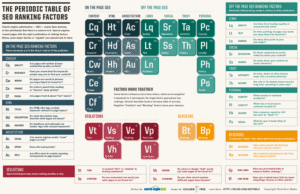SEO — search engine optimisation — is one of the most important digital marketing tactics available to organisations but it’s often considered a dark art.
An interesting diagrammatic representation of some of the factors was created by Search Engine Land’s Danny Sullivan in an illustration which he called ‘The Periodic Table of SEO Ranking Factors’.

It is designed to visually present the major factors that can help you in gaining traffic from search engines: it’s focused on traffic from general Web search results rather than video or other specialist searches.
There are on-the-page and off-the-page factors. On-the-page factors are the things that a publisher can control directly by encouraging relevant content: off-the-page factors — like inbound and outbound links and page click-through success — are things you can only influence indirectly.
Violations are the things you should avoid, common mistakes that result in negative search engine ranking. Blocked covers a new class of not-violations but still factors that can be harmful.Within each of these major groups are individual factors and there could be many more than are shown. However, Search Engine Land made a deliberate decision to show only the most important factors, verified by SEO data or commonly-accepted and easily implementable.
For example, in HTML factors, they recommend that your pages should have good, unique titles, that they should have structure that can be reflected by header tags, and that you should use the easily-implemented description tag: in that way, you’ve probably covered 90% of the most important HTML-related factors.
In addition, some of the factors they list are more general goals rather than specific factors that can be implemented. For example, recommended social factors include attaining a good social reputation and good social shares: social activity is increasingly having an influence on search rankings. So you want a good social index and you want to be shared on a variety of networks.
This periodic factors table isn’t a replacement for more comprehensive SEO guides or reviews: it’s a complementary guide. Not everyone may agree with how they’ve weighted the factors but it’s a good guide to a rapid SEO audit.
